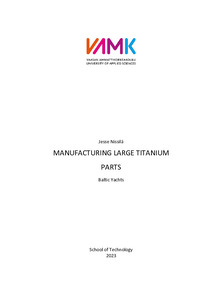Manufacturing Large Titanium Parts
Nissilä, Jesse (2023)
Nissilä, Jesse
2023
All rights reserved. This publication is copyrighted. You may download, display and print it for Your own personal use. Commercial use is prohibited.
Julkaisun pysyvä osoite on
https://urn.fi/URN:NBN:fi:amk-202305088306
https://urn.fi/URN:NBN:fi:amk-202305088306
Tiivistelmä
Opinnäytetyön aiheena on tutkia vaihtoehtoisia valmistusmenetelmiä erään huvijahdin kantosiivekkeen saranalle. Nykyisin, sarana valmistetaan titaanista jyrsimällä. Valmistus on hidasta, kallista, sekä valmistuksesta aiheutuu suuria määriä materiaalihukkaa. Opinnäytetyön tilaajana toimi jahtivalmistaja Baltic Yachts.
Opinnäytetyössä perehdyttiin valmistustekniikoihin eri lähteiden, sekä kirjallisuuden avulla. Teorian pohjalta eri menetelmien hyvät, sekä huonot puolet kartoitettiin, ja näiden sopivuutta arvioitiin tutkimuskohteen saranalle. Teoriaosuuden lisäksi saranaa yritettiin optimoida Siemens NX-mallinnusohjelmalla, sekä luotiin prototyyppi lisäävän valmistuksen keinoin.
Tutkimuksen pohjalta, kantosiivekkeen sarana olisi mahdollista valmistaa lisäävän valmistuksen suorakerrostusmenetelmien avulla. Osan optimointi, sekä suorakerrostusmenetelmät vaativat kuitenkin lisää tutkimusta tulevaisuudessa. The aim of this thesis was to research alternative manufacturing methods for a hinge piece for a yacht. This hinge connects a hydrofoil wing into the hull of the yacht. Currently, the hinge is manufactured by milling from titanium. Manufacturing is slow, expensive and produces lots of material waste. This thesis was done for Baltic Yachts, a luxury yacht manufacturer.
In the thesis, various manufacturing techniques were researched through different sources and literature. Based on the theory, the advantages and disadvantages of different methods were identified and their suitability was evaluated for the hinge of the research subject. In addition to the theoretical part, the hinge was attempted to be optimized with Siemens NX modeling software and a prototype was created using additive manufacturing methods.
Based on the research, it would be possible to manufacture the hinge using additive manufacturing Direct Energy Deposition methods. However, optimization and further research of DED are required before the hinge is possible to be manufactured.
Opinnäytetyössä perehdyttiin valmistustekniikoihin eri lähteiden, sekä kirjallisuuden avulla. Teorian pohjalta eri menetelmien hyvät, sekä huonot puolet kartoitettiin, ja näiden sopivuutta arvioitiin tutkimuskohteen saranalle. Teoriaosuuden lisäksi saranaa yritettiin optimoida Siemens NX-mallinnusohjelmalla, sekä luotiin prototyyppi lisäävän valmistuksen keinoin.
Tutkimuksen pohjalta, kantosiivekkeen sarana olisi mahdollista valmistaa lisäävän valmistuksen suorakerrostusmenetelmien avulla. Osan optimointi, sekä suorakerrostusmenetelmät vaativat kuitenkin lisää tutkimusta tulevaisuudessa.
In the thesis, various manufacturing techniques were researched through different sources and literature. Based on the theory, the advantages and disadvantages of different methods were identified and their suitability was evaluated for the hinge of the research subject. In addition to the theoretical part, the hinge was attempted to be optimized with Siemens NX modeling software and a prototype was created using additive manufacturing methods.
Based on the research, it would be possible to manufacture the hinge using additive manufacturing Direct Energy Deposition methods. However, optimization and further research of DED are required before the hinge is possible to be manufactured.
